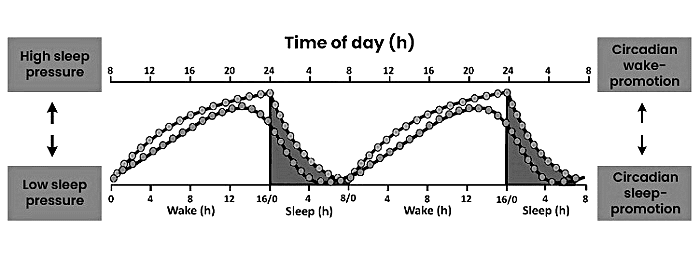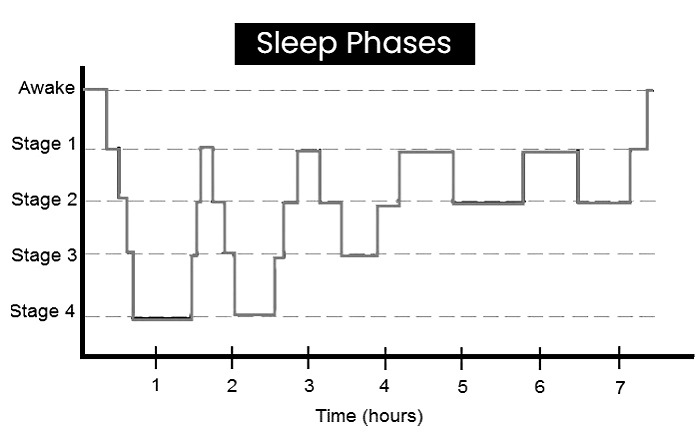Study of Consciousness Sleep Wake Schedules | Psychology for UPSC Optional (Notes) PDF Download
Introduction
The study of consciousness sleep-wake schedules focuses on understanding the intricate patterns of alternating between awake and rest states experienced by most humans. These patterns, known as the nap cycle, are regulated by the 24-hour circadian rhythm influenced by light and darkness. They have a significant impact on behavior, physical activity, and various physiological functions. The coordination of neurons in the brain and nervous system plays a crucial role in determining a person's conscious experience and awareness. In this article, we will explore the different aspects of consciousness sleep-wake schedules, including cognition, rest stages, interrupted rest schedules, and the management of wakefulness and rest.
Cognition and Sleep-Wake Cognition
Cognition refers to a person's internal and external awareness, encompassing their thoughts and conscious experiences. It heavily relies on the coordinated activity of numerous neurons in the brain and nervous system. The cognition system, a network comprising the cortex and subcortical brain regions, maintains focus, alertness, and awareness. While rest is a natural subconscious state, certain conditions can lead to a decrease or loss of awareness. The level of awareness and cognition can vary from person to person. Understanding the relationship between cognition and sleep-wake schedules is essential in comprehending the complexities of consciousness.
Designated Cognition Sleep-Wake (NAP)
During rest, the body and brain exhibit reduced activity in response to external stimuli. Voluntary muscles become less active, and the senses are largely muted. This disruption of the normal state of mind is considered therapeutic unless it negatively impacts an individual's daily life. The rest stage can be divided into two categories: Rapid Eye Activity Rest (REM) and Non-Rapid Eye Activity Rest (NREM). These stages play a crucial role in regulating various physiological functions.

Rapid Eye Activity Rest (REM)
REM rest is characterized by increased brain activity, as observed in electroencephalogram (EEG) readings, compared to wakefulness. During this stage, nearly all bodily muscles experience paralysis, known as REM atonia, except for the respiratory and extraocular muscles. The sympathetic nervous system takes over, leading to accelerated breathing and heart rates. Additionally, the brain generates vivid images and experiences, commonly known as dreams, during the REM phase.
Non-Rapid Eye Activity Rest (NREM)
NREM rest is characterized by slow, low-frequency EEG signals. It can be further divided into four phases based on the progressive slowing of brain activity and the frequency of produced waves. Unlike REM rest, rapid ocular activity and muscular paralysis are not commonly observed during NREM rest. Heart rate, breathing rate, and kidney function decrease, while digestive activity improves due to increased parasympathetic activity.
Interrupted Rest Schedule
Throughout the night, a natural alternation occurs between NREM and REM rest. The initial NREM-REM cycle typically lasts between 70 and 100 minutes, while subsequent cycles last between 90 and 120 minutes. A rest episode begins with NREM stage 1 rest and progresses through stages 2, 3, and 4. After waking up from NREM rest, the individual goes through the rest phases until reaching REM rest. This pattern continues throughout the night, with an increasing proportion of REM rest and stage 2 NREM rest becoming the dominant stage in later cycles.

Management of Wakefulness and Rest
The nap cycle is regulated by a complex network of neuronal and endocrine controls. The reticular activating system (RAS) in the brainstem and the Suprachiasmatic Nucleus (SCN) in the hypothalamus play crucial roles in controlling wakefulness and rest, respectively. The RAS, located in the anterior brainstem, is the primary neurological hub responsible for regulating cortical alertness, wakefulness, and attention. It consists of four main components, including the Corpus Coeruleus, which contains noradrenergic nerve cells that extend to the frontal cortex. The activity of the RAS is influenced by the Hypocretin originating in the lateral hypothalamus, which is associated with various sleep disorders.
The raphe contains serotonin-containing cells responsible for relaying information to the Suprachiasmatic Nucleus, which controls arousal, focus, and circadian rhythm. Another component, the Guarantee Ensures Nucleus, consists of histaminergic neurons crucial for alertness, learning, and memory. The hypothalamic nuclei have a significant role in regulating RAS activity and the body's 24-hour nap cycle.
The Suprachiasmatic Nucleus (SCN), located above the optic chiasm, serves as the primary circadian clock in the human brain. It receives information about the brightness of the environment from the retina, allowing it to create circadian cycles of rest and wakefulness. The pineal gland, stimulated by the SCN, secretes the hormone melatonin, whose release is dependent on the circadian cycle. Melatonin production peaks at around midnight, just before rest time, and gradually decreases until dawn when normalcy is reestablished. However, prolonged exposure to blue light emitted by screens can suppress melatonin secretion, making it more challenging to rest after late and extensive screen usage.
Conclusion
The study of consciousness sleep-wake schedules reveals that the demarcation between waking and rest does not indicate narrow types of conscious states. Both waking and rest stages are accompanied by abundant spontaneous thoughts and sensations, which can manifest in different forms, such as imagistic or thought-like experiences. Although further research is needed to fully understand the immersive imagistic experiences during waking, it is evident that consciousness is not solely reliant on behavioral conditions. By exploring the intricacies of consciousness sleep-wake schedules, researchers gain valuable insights into the functioning of the human mind and the complexities of conscious experiences.
|
160 videos|215 docs
|




















